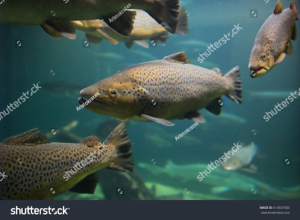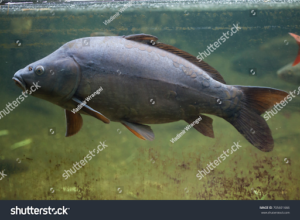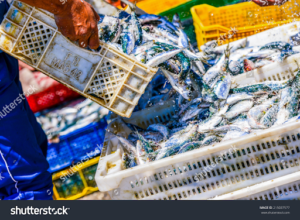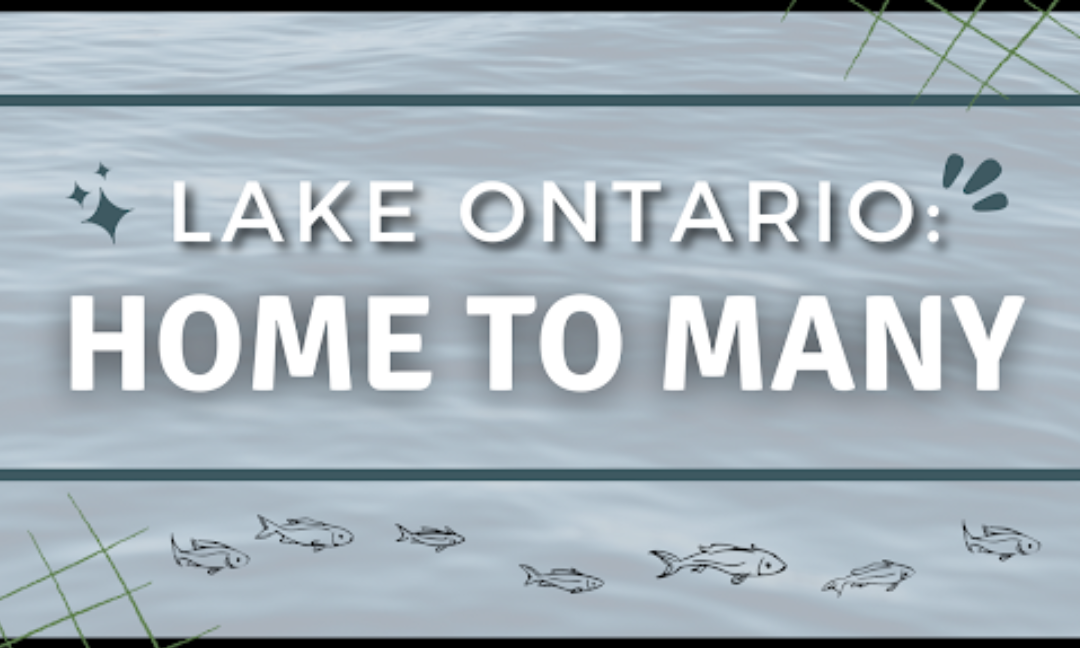Lake Ontario-Home To Many
Written By: Deana Bjedi
Edited By: Deana Bjedi
Designed By: Deana Bjedi
Published By: Samantha Porte
Lake Ontario may be the smallest Great Lake in surface area, but that doesn’t make it any less popular. Lake Ontario is one of Ontario’s biggest tourist attractions as it is home to over 100 beaches and the Toronto Islands. It also provides over 9 million people in Canada and the U.S with drinking water, but besides all of the benefits it provides for us humans, it is also home to lots of wildlife. Unfortunately, local species of Lake Ontario are being threatened by pollution, invasive species, overfishing, and more. As a result, we need to take action quickly in order to protect this major Great Lake!
Species in Lake Ontario
Like many other bodies of water, Lake Ontario is home to many native species such as phytoplankton, zooplankton, macroinvertebrates, and many diverse fish species. The countless fish species make Lake Ontario a very common location for fishing Atlantic Salmon, Smallmouth bass, Rainbow trout, etc. Sadly,
 the variety of fish has also made Lake Ontario a victim to overfishing. Furthermore, there are also invasive species threatening this lake’s natural biodiversity. For example, one of the main invaders present in multiple bodies of water throughout North America (including Lake Ontario) is the Asian Carp.
the variety of fish has also made Lake Ontario a victim to overfishing. Furthermore, there are also invasive species threatening this lake’s natural biodiversity. For example, one of the main invaders present in multiple bodies of water throughout North America (including Lake Ontario) is the Asian Carp.
What Threatens Lake Ontario?
Unfortunately, there are many factors threatening the species of this Great Lake. These factors include overfishing, invasive species and water pollution. As mentioned, overfishing has greatly threatened the fish population in Lake Ontario, thus causing it to rapidly decrease. This has negative effects on this Great Lake’s ecosystem and food chains because all species depend on each other for survival. The Asian Carp is also a factor threatening native fish. This invasive species poses a threat to native fish because it consumes dangerous amounts of the food native fish need to survive. To illustrate, the Asian Carp eats as much as 40 percent of its body weight each day and can weigh up to 40kg and be over a meter long! They also reproduce at an alarming rate with females being able to lay up to 1 million eggs in one spawning event. This could definitely lead to an astronomical population of invasive fish if not prevented.

 However, we humans have also been instigating other disasters that greatly impact the ecosystem.
However, we humans have also been instigating other disasters that greatly impact the ecosystem.
A mostly
human-caused threat to this lake is water pollution. Water pollution is especially present in Lake Ontario because the other lakes flow into it and add in their share of pollution. This lake, being a popular location for tourists and residents, also makes it susceptible to littering and as a result, more pollution.
Taking Action
There is a lot threatening Lake Ontario so we need to take action and do our share to protect this lake and its species from further damage. In order to avoid further damaging Lake Ontario, here’s what to do:



- Inform yourself about invasive species near you and report sightings at 1-800-563-7711 (Ontario’s Invading Species Hotline)
- Join clean-up events of bodies of water in your community
- Do not litter!
- Use less road salts and fertilizers and choose non-toxic soaps, detergents and cleaners because they may end up back in water streams
- If you see a spill, report to the Spills Action Centre at 1-800-268-6060
- Conserve water and energy
In conclusion, Canadians are very lucky to be surrounded by so much water. This gives us the great responsibility to protect our water and the species that were there before us. We should all stay informed and be mindful of how our actions affect our Great Lakes.
________________________
Works Cited
Becker, Marissa. “Top 10 Interesting Facts About Lake Ontario.” Animal Stratosphere, 13 April 2021, https://animalstratosphere.com/lake-ontario-facts/. Accessed 20 July 2022.
Lockhart, Jessica Wynne. “20 amazing facts about Lake Ontario.” Cottage Life, 19 June 2022, https://cottagelife.com/outdoors/20-amazing-facts-about-lake-ontario/. Accessed 20 July 2022.
Ontario. “Ontario’s Great Lakes Strategy | ontario.ca.” Ontario.ca, 21 October 2021, https://www.ontario.ca/page/ontarios-great-lakes-strategy#section-2. Accessed 20 July 2022.
Ontario’s Invading Species Awareness Program. “Asian Carps | Ontario’s Invading Species Awareness Program.” Ontario’s Invading Species Awareness Program |, 2021, http://www.invadingspecies.com/invaders/fish/asian-carps/. Accessed 21 July 2022.
Pond Informer. “List of Fish Species in Lake Ontario 2022 [Updated].” Pond Informer, 3 March 2022, https://pondinformer.com/lake-ontario-fish-species/. Accessed 20 July 2022.
Zimmermann, Kim Ann. “Lake Ontario Facts.” Live Science, 29 June 2017, https://www.livescience.com/34571-lake-ontario.html. Accessed 20 July 2022.
Image Sources
https://www.shutterstock.com/image-photo/salmon-race-615657503
https://www.shutterstock.com/image-photo/fisherman-pouring-freshly-cought-fish-one-215037577
https://www.shutterstock.com/image-photo/plastic-rubbish-pollution-ocean-environment-427946419
https://www.shutterstock.com/image-photo/mirror-carp-cyprinus-carpio-705691666
https://www.shutterstock.com/image-vector/no-littering-allowed-sign-crossed-out-1444357796
https://www.shutterstock.com/image-vector/non-toxic-green-outline-icon-1612991512
https://www.shutterstock.com/image-photo/woman-volunteer-black-bag-collect-garbage-1594263250

